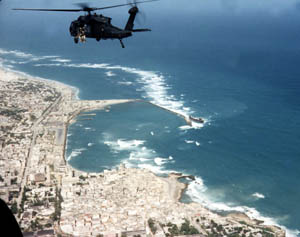Battle of Mogadishu (1993)
 The Battle of Mogadishu (), also known as the Black Hawk Down Incident, was part of Operation Gothic Serpent. It was fought on 3–4 October 1993, in Mogadishu, Somalia, between forces of the United States—supported by UNOSOM II—against Somali National Alliance (SNA) fighters and other insurgents in south Mogadishu.
The Battle of Mogadishu (), also known as the Black Hawk Down Incident, was part of Operation Gothic Serpent. It was fought on 3–4 October 1993, in Mogadishu, Somalia, between forces of the United States—supported by UNOSOM II—against Somali National Alliance (SNA) fighters and other insurgents in south Mogadishu.The battle took place during the UNOSOM II phase of the United Nations (UN) intervention in the Somali Civil War. The UN had initially dispatched forces to alleviate the 1992 famine, but then shifted to attempting to restore a central government and establishing a democracy. In June 1993, UNOSOM II forces suffered significant losses when the Pakistani troops were attacked while inspecting a SNA radio station and weapons-storage site. UNOSOM blamed SNA leader General Mohammed Farah Aidid and began military operations against him. In July 1993, U.S. forces in Mogadishu conducted the Bloody Monday raid, killing many elders and prominent members of Aidid's clan, the Habr Gidr. The raid led many Somalis to either join or support the growing insurgency against UNOSOM forces, and US forces started being deliberately targeted for the first time. This, in turn, led American president Bill Clinton to initiate Operation Gothic Serpent in order to capture Aidid.
On 3 October 1993, U.S. forces planned to seize two of Aidid's top lieutenants during a meeting deep in the city. The raid was only intended to last an hour but morphed into an overnight standoff and rescue operation extending into the daylight hours of the next day. While the goal of the operation was achieved, it was a pyrrhic victory and spiraled into the deadly Battle of Mogadishu. As the operation was ongoing, Somali insurgents shot down three American Black Hawk helicopters using RPG-7s, with two crashing deep in hostile territory, resulting in the capture of an American pilot. A desperate defense of the two downed helicopters began and fighting lasted through the night to defend the survivors of the crashes. Through the night and into the next morning, a large UNOSOMII armored convoy consisting of Pakistani, Malaysian and American troops pushed through the city to relieve the besieged troops and withdrew incurring further casualties but rescuing the survivors.''''
No battle since the Vietnam War had killed so many U.S. troops. Casualties included 18 dead American soldiers and 73 wounded, with Malaysian forces suffering one death and seven wounded, and Pakistani forces two injuries. Somali casualties, a mixture of insurgents and civilians, were far higher; most estimates are between 133 and 700 dead.
After the battle, dead US troops were dragged through the streets by enraged Somalis, an act that was broadcast on American television to public outcry. The battle led to the end of Operation Gothic Serpent and UNOSOM II military operations, which Somali insurgents saw as victory. By early 1995, all UN forces withdrew from Somalia. Fear of a repeat drove American reluctance to increase direct involvement in Somalia and other parts of Africa, including during the 1994 Rwandan genocide. It has commonly been referred to as "Somalia Syndrome". Provided by Wikipedia

